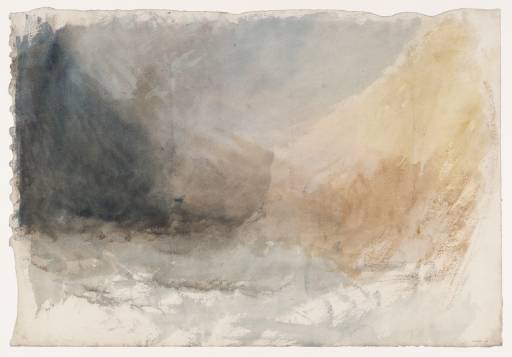Joseph Mallord William Turner Land's End c.1834
Joseph Mallord William Turner,
Land's End
c.1834
Joseph Mallord William Turner 1775–1851
Land’s End c.1834
D25165
Turner Bequest CCLXIII 43
Turner Bequest CCLXIII 43
Watercolour on white wove paper, 352 x 511 mm
Watermark ‘Ruse & Turners | 1828’
Blind-stamped with Turner Bequest monogram towards bottom centre
Stamped in black ‘CCLXIII – 43’ bottom right
Watermark ‘Ruse & Turners | 1828’
Blind-stamped with Turner Bequest monogram towards bottom centre
Stamped in black ‘CCLXIII – 43’ bottom right
Accepted by the nation as part of the Turner Bequest 1856
Exhibition history
1997
Turner’s Watercolour Explorations 1810–1842, Tate Gallery, London, February–June 1997, Southampton City Art Gallery, June–September 1997 (70, reproduced in colour, as ‘Compositional, Colour and Underpainting Study for Longships Lighthouse, Land’s End’, c.1834).
2006
Light into Colour: Turner in the South West, Tate St Ives, January–May 2006, Plymouth City Museum and Art Gallery, May–August 2006 (no number, reproduced in colour, as ‘Longships Lighthouse’, c.1834).
2013
Turner from the Tate: The Making of a Master, Art Gallery of South Australia, Adelaide, February–May 2013, National Gallery of Australia, Canberra, June–September 2013 (82, reproduced in colour, as ‘Compositional, Colour and Underpainting Study for Longships Lighthouse, Land’s End’, c.1834).
References
1909
A.J. Finberg, A Complete Inventory of the Drawings of the Turner Bequest, London 1909, vol.II, p.817, CCLXIII 43, as ‘Lake, with mountains’. c.1820–30.
1997
Eric Shanes, Turner’s Watercolour Explorations 1810–1842, exhibition catalogue, Tate Gallery, London 1997, pp.18, 21, 81, 95, 98, 101, 104 (p.81 no.70, reproduced in colour, as ‘Compositional, Colour and Underpainting Study for Longships Lighthouse, Land’s End’. c.1834, p.95 Appendix I under ‘England and Wales Series’, as ‘Study for Longships Lighthouse, Land’s End’. c.1834, p.98 under ‘Land’s End, Cornwall’, as ‘Study for Longships Lighthouse, Land’s End’. c.1834, p.101 under ‘Sea Sketches and Studies’, p.104 Appendix II, as ‘Study: Longships Lighthouse, Land’s End’).
2006
Sam Smiles, Light into Colour: Turner in the South West, exhibition catalogue, Tate St Ives 2006, reproduced in colour p.8, as ‘Longships Lighthouse’. c.1834.
2007
Max Hollein and Raphael Rosenberg, Turner Hugo Moreau: Entdeckung der Abstraktion, exhibition catalogue, Schirn Kunsthalle, Frankfurt 2007, Abb.37 (colour), as ‘Studie für die Farb- und Helldunkel-komposition von »Leuchtturm von Longships, Land’s End«’. um 1834.
This is one of eight ‘colour beginnings’ catalogued here as Land’s End subjects; the others are Tate D25129, D25163, D25172, D25274, D36323, D36324 and D36326 (Turner Bequest CCLXIII 7, 41, 50, 152, CCCLXV 32, 33, 35). A further colour study has been proposed as a Land’s End view among other possibilities (Tate D25185; Turner Bequest CCLXIII 63). For Turner’s 1811 pencil sketches at Land’s End, see under D25129.
Noting Ian Warrell’s unpublished identification of the present colour study,1 Eric Shanes has suggested it, D25163, D25274 and D36326 (CCLXIII 41, 152, CCCLXV 35) relate in varying degrees to the watercolour Longships Lighthouse, Land’s End of about 1834 (J. Paul Getty Museum, Los Angeles),2 engraved in 1836 for the Picturesque Views in England and Wales (no impressions held at Tate).3 The most closely related pencil study in the 1811 Cornwall and Devon sketchbook (albeit with many variations) is Tate D41303 (Turner Bequest CXXV a 27). Of the four colour studies, this is the most directly comparable to the completed design in its strong structure and colour. Shanes has described it as setting the scene for the ‘moral agenda’ of a shipwreck subject, expressing ‘mankind’s hubristic attempt’, in the form of the lighthouse (not indicated here but seen on the horizon in the England and Wales view), to overcome nature, the failure of which is shown by wreckage in the foreground of the finished watercolour.4
See also the introductions to the present subsection of identified subjects and the overall England and Wales ‘colour beginnings’ grouping to which this work has been assigned.
Technical notes:
The left-hand edge has been torn very roughly, leaving serrations. Eric Shanes notes that the paper is the ‘same’ as for the colour studies Tate D25167–D25171, D25184 and D25208 (Turner Bequest CCLXIII 45–49, 62, 86).1 The ‘Ruse & Turners’ watermark was current from 1805 to the 1840s, representing various permutations of partners (Richard Turner and Mr Letts by 1828) producing paper at Upper Tovil Mill, Maidstone, Kent.2
The left-hand edge has been torn very roughly, leaving serrations. Eric Shanes notes that the paper is the ‘same’ as for the colour studies Tate D25167–D25171, D25184 and D25208 (Turner Bequest CCLXIII 45–49, 62, 86).1 The ‘Ruse & Turners’ watermark was current from 1805 to the 1840s, representing various permutations of partners (Richard Turner and Mr Letts by 1828) producing paper at Upper Tovil Mill, Maidstone, Kent.2
Verso:
Blank (not examined out of frame).
Blank (not examined out of frame).
Matthew Imms
March 2013
How to cite
Matthew Imms, ‘Land’s End c.1834 by Joseph Mallord William Turner’, catalogue entry, March 2013, in David Blayney Brown (ed.), J.M.W. Turner: Sketchbooks, Drawings and Watercolours, Tate Research Publication, December 2013, https://www

